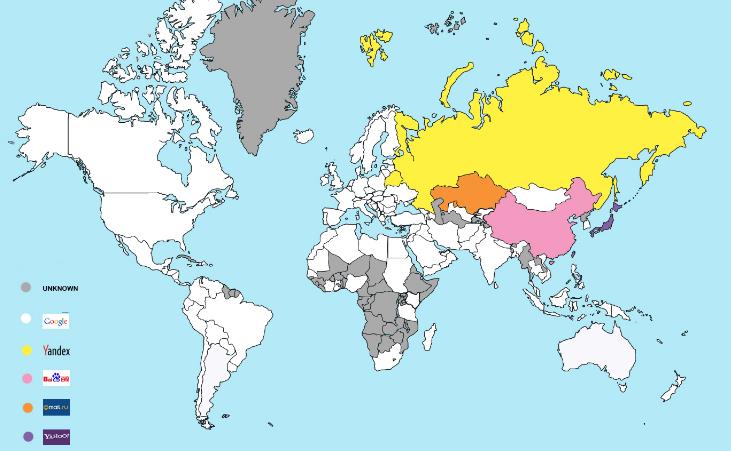A Complete Guide to International SEO

When tackling an international SEO positioning project, it is important to have clearly defined ideas that may vary with regards to what can be done in a strategy on local or national search engines. And in this case, the objective is not to position your website on your national search engine, but rather on one where searches may be in a different language, the competition is different, etc.
Índice de contenidos
Index of contents
Index du contenu
Inhaltsverzeichnis
Indice dei contenuti
Before you start... 3 questions about international SEO
To control these differences, it is important to ask yourself 3 questions. The answers will give you a better idea as to whether your strategy to make your website visible on an international level will be successful, or whether you have to rework it.
1. Is your website prepared? Before showing it off, make sure it is fully adapted. In other words, ensure that you have all the texts translated into the language in question, that they are SEO optimised and that they have the basic Google-friendly characteristics that should be present on all good websites. It makes no sense to position a page based on words in one language when the content is in another language.
2. What are users looking for in the specific country? Another country almost always implies another culture. Different ways of thinking, talking and searching. It is extremely important to maximise the potential of Google's keyword tools (now called planner, which we will talk about below) to obtain thorough knowledge of what and how the users in the country in question search. Experience as to national search terms is of little help.

3. What do you have to offer when people find you? Positioning your website in the digital world for the international market implies being prepared to manage customers in that geographical area. In other words, if you have an E-Commerce, you must take into account aspects such as payment methods, currency or country-specific regulations. If you offer other services, you will need a customer service line in that particular country and somebody to address enquiries. Don't set sail until your ship is prepared.
Study of the target audience in other countries
The first and most important aspect, which is almost obvious, is that before implementing an international SEO strategy, it is necessary to conduct a thorough study of the intended target audience.
The study of the target audience in the destination countries should include factors such as the search engines that they use. We tend to assume that it will be Google and, while it is the most widely-used search engine on a global level, in other countries there are also other important search engines that are used by a high percentage of the population. For example, Baidu in China, Yahoo in Japan and Yandex in Russia, to name but a few.

Each search engine has its own algorithm and positioning rules, and knowledge of such aspects is advisable so that you know which rules you have to play with and how you can optimise your website to reach the highest number of potential customers.
Consultants such as Forrester Research, Experian and ComsCore, among others, publish regular reports with information about the market share held by each search engine in each country. Therefore, it is useful to take a look at these reports when deciding on the international SEO strategy that you want to implement.
Other aspects that you should take into account initially about the target audience is whether they have any type of limitation when accessing the Internet, the percentage of Internet access from different devices and learning about other aggregators, social networks and 2.0 sites that are relevant in the destination country where you want to advertise your business.

Content in your international positioning
Machine translation of your contents is the least recommended option. It is the simplest option, and it does not interfere with indexing, but it does have an impact on the quality of the contents and, above all, it means not doing a full and complete job. All of the optimisation efforts made for a website on a national level must also be employed when entering the international market.
This implies, once again, studying the target audience, learning about how they talk, the terms and expressions that they use and how they use search engines. It is necessary to take into account the country context.
Although English is spoken in both the United Kingdom and America, the same expressions and words are not used for the same things, sometimes the sense is changed, etc. The same thing happens in other languages, such as Spanish. And it is paramount to be aware of this when optimising contents during an international SEO campaign.
Therefore, the best option is to localise the contents, making it possible to adapt them to the characteristics of the audience of each site.

It is also necessary to conduct keywords research, taking into account all of the above and the sales points used in the destination countries.
Thus, the search terms established after conducting the research, based on their potential to generate quality traffic on the search engines used by the audience, will bring the contents to life. Furthermore, SEO tags such as titles, H1, anchor, text, ALT, etc., should also be optimised, as for all content optimisation strategies.
Website architecture
Another key point, and maybe one of the most cumbersome or delicate aspects when implementing an international SEO campaign, are all the technical details, such as the website architecture, the domains, etc.
Several questions arise before addressing these aspects: what about the main website? do I have to create a new website? do I have to create a different website for each target country? am I highly dependent on the traffic from a single keyword? can I generate popularity towards a subdomain? what is the level of popularity of the competition and which domains do they have?
According to each specific case, these questions and their answers will help you to understand how to act. International versions of a website can be developed in subdirectories or subdomains.
If you place priority on the transmission of link juice, subdirectories are the best option, while if you place priority on the amount of pages to index, subdomains are the best option.
Before explaining the different web architecture options in more detail, I would like to discuss the different types of domains when working in an international context:
- Generic Top Level Domains (gTLD's): they are not associated to a specific country, but rather they are generic, such as .net, .org, .eu, etc.
- Country code Top Level Domains – ccTLD's: domains that are associated to specific countries, .es for Spain, .fr for France, .de for Germany, etc.
- IDN (Internationalised Domain Names): these refer to Internet domain names that usually contain non-ASCII characters such as diacritics or special characters in certain Latin scripts such as Spanish or Arabic. Such domain names pose several problems when setting up tools such as Google Analytics, Web Mastertools, etc. and their use is not advisable.
ccTLD domains are better positioned in the corresponding country. It is advisable to host the domain on a server that is geolocated in the country.

To host international domains, the following is recommended:
ccTLD's should be hosted in each corresponding country to improve website loading times and the user experience.
- Generate incoming links and links on social networks from domains in the country to the contents of your domain.
Types of web architecture.
- Language-specific domain strategy: myweb.fr / myweb.es / myweb.de, etc. or subdomains according to language: es.myweb.com / fr.myweb.com / en.myweb.com / de.myweb.com. They are independent websites.
Each domain is indexed independently, enabling semantic URLs in each language.
This strategy is simple to implement, geotargeting can be set up in Webmaster Tools, enabling different servers for each country and a clear site separation. The main disadvantage is that the link juice and main domain authority will not be distributed through the domains or subdomains and a lot more links have to be created separately. Therefore, the linkbuilding strategy is more extensive and costly. It also implies that if you want to "access" a new country, the website will start with 0 authority in that country.
- Language-specific subdirectory strategy with a single domain and 301 redirects from territorial domains: myweb.com/es/, myweb.com/fr/, myweb.com/de/, etc.
Strength is taken from the main website, the link juice flows and by focusing on a single domain, it develops much more authority. Thus, when a new destination website is opened, the advantage is that it already has that authority from the outset.
One of the main disadvantages of this strategy is that loading time is much slower, unless WPO is well implemented.
- Subfolders according to languages under a domain and territorial domains with microsites.
This option is much more complex and difficult to maintain because microsites must be developed for each territorial domain and it is not as effective as other options, and therefore less recommended.
- Different domain name for each language and/or country, implying independent websites.
This strategy provides greater presence in each destination country and makes it possible to work with greater autonomy, agility and flexibility on a local level.

The hreflang attribute, the key to your SEO in other languages
As we have seen above, in an international website positioning strategy when the website has several languages or different ccTLD's, there are a series of factors that must be carefully considered to ensure that Google understands us. In this respect, it is fundamental to implement the hreflang tag: rel=”alternate” hreflang=”x”
This attribute helps Google to understand that there are different URLs with the same content that has been translated or segmented for users from different countries. It identifies the language and, optionally, the region of an alternative URL.
When is it necessary to use the hreflang attribute?
- When the main content is in a single language and the template, navigation menu and footer have been translated.
- When the content has several regional variations although the language is the same, such as text in English for an American or British audience.
- When the content has been translated in full, and there are different versions of each page: in Italian, in French, in Spanish, etc.
How is the hreflang attribute implemented?
1. In the case of a website in several different languages: /es, /de, /it, in addition to the English version which is the main site. To use the hreflang tag, it is necessary to go to the home section of the English version and add the urls of the other languages:
<link rel=“alternate” hreflang=“es” href=http://www.myweb.com/es />
<link rel=“alternate” hreflang=“de” href=http://www.myweb.com/de />
<link rel=“alternate” hreflang=“it” href=http://www.myweb.com/it />

We will have to do the same in the rest of the languages to adapt them. If you are now in the Spanish version of the page (es), the urls of the other languages will have to be added to the home section of the Spanish version:
<link rel=“alternate” hreflang=“en” href=http://www.myweb.com/en />
<link rel=“alternate” hreflang=“de” href=http://www.myweb.com/de />
<link rel=“alternate” hreflang=“it” href=http://www.myweb.com/it />
2. In the case of a website with the same language but different geographical areas. For example, you may have the same content but segmented for English speakers in Canada (en-ca) and those in Australia (en-au), along with the general version in English (en). In the home section of each of the three pages the following code should be included:
<link rel=“alternate” hreflang=“en-en” href=http://www.myweb.com/en />
<link rel=“alternate” hreflang=“en-ca” href=http://www.myweb.com/ca />
<link rel=“alternate” hreflang=“en-au” href=http://www.myweb.com/au />
In short, providing Google with the greatest amount of information possible about the alternative versions according to language/country means that search results will be better adapted to users, thus offering greater chances of success. That is why it is so important to use this tag correctly depending on each specific case.
The geolocation of contents
Generally, search engines tend to favour local contents in their results. There are several different options or techniques for geolocation:
- Content Delivery Network: refers to a series of servers in different points of a network that contain local copies of certain contents. They are stored on other servers that are generally geographically far away.
- Physical geolocation of the hosting servers: many suppliers enable you to select where you want to locate each hosting plan for your website because they have data centres in several countries.

- Establish the geographical orientation in Google Search Console: based on the URL structure selected in Settings – Geographical Orientation, indicating the target country of the domain, subdomain or subdirectory.
A different profile should be created in Webmaster Tools for each ccLTD, subdirectory or subdomain to which the segmentation applies. If segmentation is carried out according to language and one language applies to several countries, it is better not to specify geotargeting.
- Local indicators: such as telephone numbers from the destination country or other country-specific forms of contact.
Linkbuilding for your international SEO

One of the fundamental aspects within any SEO strategy is the generation of links, and this is also true in the case of a positioning campaign in other countries.
The links must be relevant in the destination countries/languages; it is not simply a matter of occupying a good position in searches. This relevance can be achieved through quality links from the countries/languages in which the positioning is required
The linkbuilding strategy should be geographically focused. It should adapt to the new environment, taking into account that users in each country have different interests. Because what worked in the original version may not be so effective in other places.
Other articles you may be interested in:

In digital marketing for several years, I have specialized in content creation and optimization, as well as in digital project management. SEO, branded content and storytelling are my best friends. ;)



Add new comment